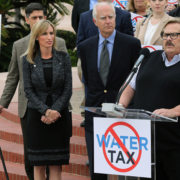We’ve got a great thing going here in San Diego County, from the mountains to the coast and from the far northern reaches of our region to the international border.
Our economy is strong – one of the largest in the nation – with everything from global giants to startups trying to make a splash. We’ve got the most small farms of any county in the country and innovative industries that put us on the map.
And our quality of life is second to none. People come from all over the world to play here and stay here. They come for our attractions, our beer, our climate and everything else this great region offers.
That makes me proud to call this place home. And it reminds me that none of this would be possible without one key ingredient: a safe and reliable water supply.
Sufficient water supplies required for San Diego’s advanced economy
Think about it: We get just 10 inches of rain a year at Lindbergh Field. That’s not enough to sustain even a small fraction of what we do here day in and day out. In fact, the last time our natural water resources were sufficient for San Diego County was 1946.
At the time, San Diego was just at the start of its renaissance, first as a center of military operations, and later as one of the largest, most vibrant metropolitan areas in the nation.
Today, we boast an advanced economy that’s still a key military hub, and also a center of manufacturing, brewing, tourism, agriculture and so much else.
There are lots of reasons for our collective success, but none more foundational than steady and sufficient water supplies. Water is critical for developing new smart phone technology, next-generation medicines, high-tech military ships and world-class guitars and banjos. And the list goes on.
That’s where the San Diego County Water Authority and its 24 member agencies come in. Together, we secure, treat and deliver this vital resource 24/7/365.
We do it in pioneering and innovative ways, like new and enlarged reservoirs and the nation’s largest seawater desalination plant. We also work the front lines of water-use efficiency with rebates and resources to stretch every drop, because we appreciate the value of the region’s investments in safe and reliable water supplies.
So, every time you slice an avocado on your salad, use your smartphone for directions to the Gaslamp, watch your kid hit a home run on a Little League field, or stroll the tree-lined trails of Balboa Park, remember that this San Diego life is Brought to You by Water.
For more on the Water Authority’s Brought to You by Water program, go to https://b2ubyh2o.org/.




